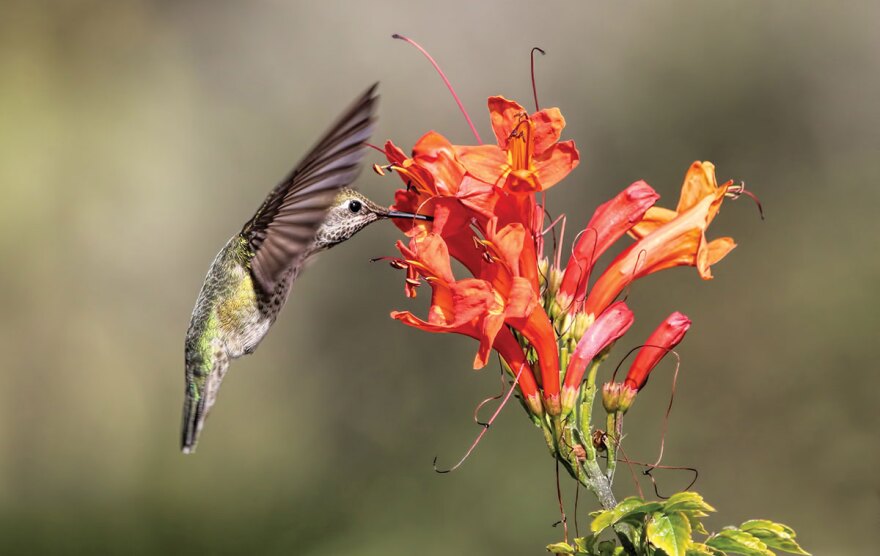This spring, plant these beauties to attract birds, bees, and butterflies to your yard
Part of the joy of gardening isn’t about the plants, it’s about the animals — the birds, butterflies and other fauna that find flowers as attractive as you do. Here are some of my favorite plants for luring a little wildlife to your home.
Sky Flower
If you have a spot with a bit of shade and are looking to draw hummingbirds and especially butterflies, consider the Sky Flower. This plant grows as a shrub, but can be trained into a small tree, reaching 10 to 15 feet in height and width over time. Thousands of gorgeous purple flowers with a delicate white rim adorn this tree from spring to fall and are followed by small orange berries. Sky Flower is a moderate-water-use evergreen plant that’s hardy to about 20-25 degrees. While young plants may be killed by a hard frost, a mature specimen will generally recover from any cold damage.
From left: Sky Flower, Baja Fairy Duster, Globe Mallow, Tecoma, Cape Honeysuckle, Texas Olive and Twisted Acacia
Baja Fairy duster
Thriving in full sun or some shade, the Baja Fairy Duster delivers deep red feather-duster flowers from spring through fall. This drought-tolerant shrub will hold its leaves in mild winter conditions. If it does drop its leaves due to cold temperatures, don’t worry. The leaves and the flowers will flush out just as the heat returns. At full size, it can reach 5 feet high and wide, so give this plant room to grow. Want a smaller version? Pink Fairy Duster is very similar in terms of care and form, but stays smaller at about 3 by 3 feet, with pink blossoms.
Globe Mallow
Have you ever noticed those bright orange- to coral-colored cup-shaped flowers blooming out in the wild desert and vacant lots? Globe Mallow loves hot, sunny spots, and it puts on a reliable and spectacular spring flower show that’ll draw in both hummingbirds and butterflies. It’ll fill in quickly and can grow to 3 feet high and wide. Once the first round of flowers is spent, you can deadhead the shrub to push new blooms. This drought-tolerant plant can reseed itself readily, so get it established and then back off the water.
Tecoma
Tecoma hybrids, like Lydia Bells, Bells of Fire and Sparklette Bells, drive hummingbirds crazy. This family of plants can tolerate the sun very well with regular water, providing a nonstop display of showy flowers from late spring until the cool weather of autumn. They usually drop their leaves in winter and can freeze to the ground in a cold year, but rebound when temperatures warm up. Prune them back in early spring to shape, or prune as needed to maintain attractive form.
Cape Honeysuckle
A close relative to the hybrids, Cape Honeysuckle is a durable plant that can be kept as a shrub or trained as a vine. Cape Honeysuckle produces a vibrant red-orange flower in the late summer and early fall that provides a stunning pop of color against its rich, dark green foliage. Left on its own, it can reach 6 to 10 feet tall and wide, but it can easily be kept in check with a little hand-pruning.
Texas Olive
If you’re searching for something that will get a little bigger and bring in the wildlife, there are a number of small, drought and heat-tolerant trees that thrive here. Texas Olive is a large shrub left on its own, but can be developed into a striking small tree that will grow from 10 to 15 feet high and wide. The olive-green leaves are unusually large for a desert tree. You and the hummers will enjoy its spring and fall blooms of clusters of white, trumpet-shaped flowers with yellow throats, and a texture reminiscent of crepe paper. This little tree isn’t a true olive, but it produces a small fruit that can feed wildlife. It’s drought-tolerant and will perform better if you move the water well away from its base after it gets established, within one year.
Twisted Acacia and Texas Ebony
You may also want to consider trees that can serve as shelter for birds and small mammals. Both Twisted Acacia and Texas Ebony are beautiful trees with exceptional architectural form. Their stiff and somewhat thorny branches protect wildlife and are ideal for bird nests. Even better, both feature spring flowers which are followed by large seedpods that serve as a food source. They’re drought-tolerant and like our nutrient-poor soils, so be careful not to over-water; move the drip emitters away from the trunk to at least 4 to 5 feet away after the first summer. Growing to 15 to 25 feet tall and wide, both of these trees can offer you and the wildlife a shady spot to relax.









